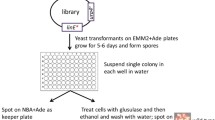Abstract.
The conditions re reviewed that must be met by any model of long distance attraction and transport of homologous chromosomes to the points of intimate DNA synapsis. A proposal for possible mechanisms is presented. It includes transcription and repair factors acting on coding sequences as a preparatory step toward pairing, and the attachment of specific pairing proteins to these sequences. Double-strand break formation is prepared but not immediately completed at the same sites. It is concluded that DNA-DNA interactions cannot bridge the distances between homologous chromosomes in the nucleus, and it is suggested that protein chains are formed between homologous segments. These attach to homologous chains emanating from homologous sequences in other chromosomes, and the chains move along each other until the homologous DNA sequences meet. Then, if required, a synaptonemal complex is formed, and exchange can take place.
Similar content being viewed by others
Author information
Authors and Affiliations
Additional information
Received: 9 April 1999 / Accepted: 7 May 1999
Rights and permissions
About this article
Cite this article
Sybenga, J. What makes homologous chromosomes find each other in meiosis? A review and an hypothesis. Chromosoma 108, 209–219 (1999). https://doi.org/10.1007/s004120050371
Issue Date:
DOI: https://doi.org/10.1007/s004120050371




